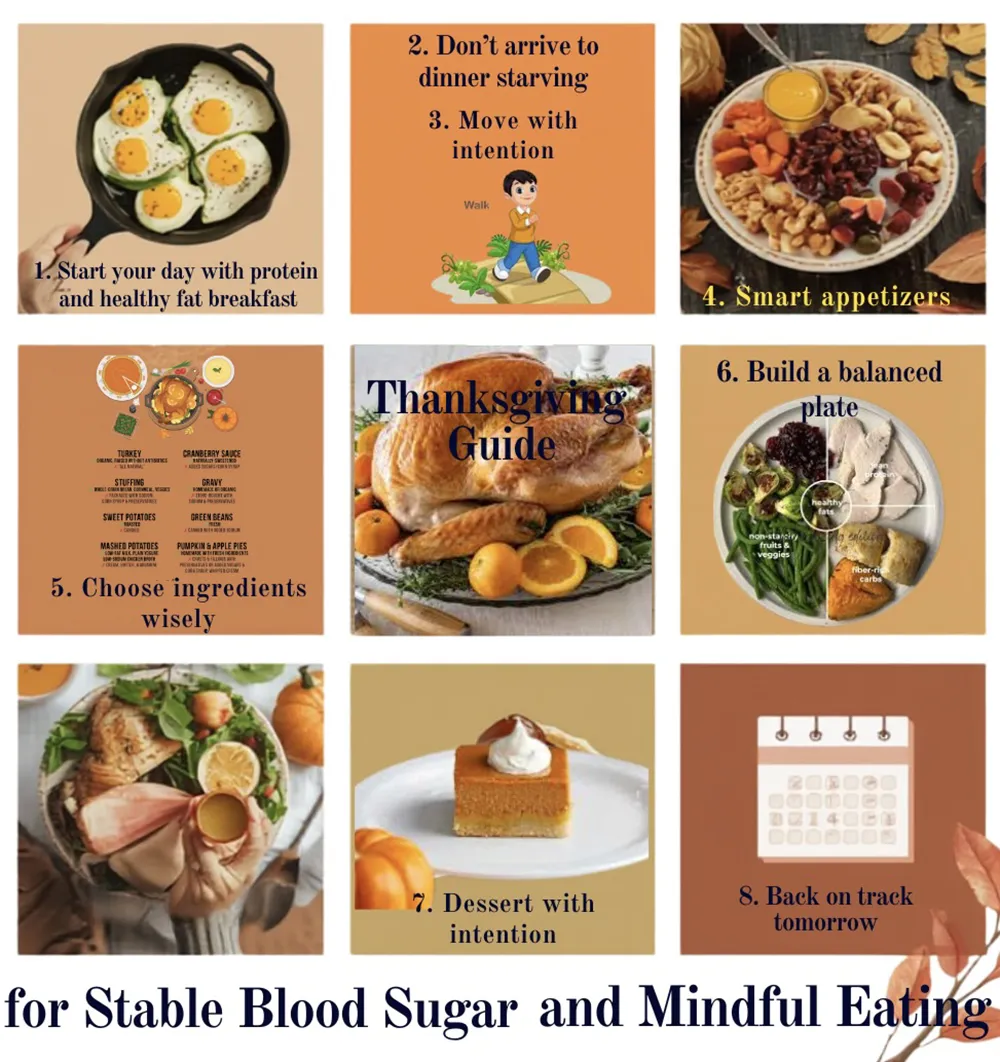by Parul Shah RD/LD
Thanksgiving is a time for connection, gratitude, and delicious food but for many people, it can also bring stress around overeating, energy crashes, and managing blood sugar. The good news? With a few simple strategies, you can enjoy every bite of your holiday meal without guilt, without restriction, and without the blood sugar rollercoaster.
Here’s your complete guide to navigating Thanksgiving with confidence and intention.
1. Start Your Day With a Protein and Healthy Fat Breakfast
Many people skip breakfast thinking they’ll “save calories” for the big meal, but arriving overly hungry can lead to overeating and faster blood sugar spikes. Instead, begin the day with a balanced, satisfying breakfast, such as:
- A two-egg omelet with vegetables and cheese
- ½ avocado on top
- A side of fruit like berries or citrus
This combination of protein, fat, and fiber keeps you full longer and helps stabilize blood sugar throughout the day.
2. Don’t Arrive to Dinner Starving
Eat your normal meals and snacks leading up to Thanksgiving dinner. Skipping meals increases cravings, slows metabolism, and makes mindful eating very difficult.
A calm steady appetite leads to better food choices and better digestion.
3. Move With Intention
Movement improves insulin sensitivity, boosts mood, and creates a metabolic buffer for the holiday meal ahead.
Simple ways to add movement:
- A family walk before or after the meal
- A fun game of flag football
- Dancing while you cook
- Stretching or light yoga
- A quick “10 squats and 10 push-ups” bathroom break if you’re traveling
Any form of movement counts it doesn’t have to be a workout.
4. Choose Smart Appetizers
The appetizer spread often sets the tone for the entire day.
Choose or bring options that support steady blood sugar:
- Veggies with hummus
- Fruit with cheese
- Deviled eggs
- Olives, nuts, and charcuterie
- Simple caprese skewers with balsamic drizzle
These foods keep you energized without filling up on bread, crackers, or chips.
5. Choose Ingredients Wisely
Small cooking choices can make a big difference in overall balance.
Consider:
- Using olive oil or avocado oil instead of butter or bacon fat
- Making cauliflower mashed potatoes for a lighter side
- Roasting vegetables with herbs for natural flavor
- Limiting added sugar in casseroles or sauces
These swaps keep meals delicious while supporting overall blood sugar control.
6. Build a Balanced Plate
Use a simple structure to keep your meal satisfying and gentle on your blood sugar.
- Start with: Non-starchy vegetables (salad, green beans, roasted veggies)
- Lean or dark-meat turkey
- Then add: Your favorite carbs in moderate portions stuffing, mashed potatoes, rolls, sweet potatoes
Eating protein and vegetables first slows digestion and leads to a smoother post meal rise in blood glucose.
7. Practice Mindful Eating
Mindful eating helps you savor your food, naturally regulate portions, and avoid the uncomfortable “holiday overfull” feeling.
Try these simple strategies:
- Take smaller bites
- Put your fork down between bites
- Take 1 to 2 relaxed breaths before the next bite
- Chew 20 to 30 times
- Alternate food and sips of water
Slow down and enjoy the experience. Surround yourself with conversation, loved ones, and gratitude not just the food.
8. Enjoy Dessert With Intention
Dessert is part of the holiday and it’s absolutely okay to enjoy it.
Instead of sampling everything, choose one dessert you truly love, take a smaller portion, and savor it slowly. Eating dessert after a balanced plate helps reduce blood sugar spikes.
9. Remember: It’s a HoliDAY, Not a HoliWeek
One meal will not make or break your health journey. What matters most is what you do consistently the rest of the year.
Enjoy your Thanksgiving, connect with loved ones, and return to your routine at your very next meal no guilt, no compensating, no extremes.
Thanksgiving is meant to be enjoyed. By tuning into your body, staying mindful, and nourishing yourself with intention, you can experience the holiday fully without feeling fatigued, bloated, or out of control.
Use these tools as a supportive framework, not a set of rules.
Your health, joy, and balance can all coexist beautifully this holiday season.




